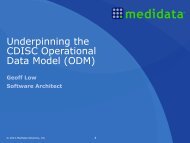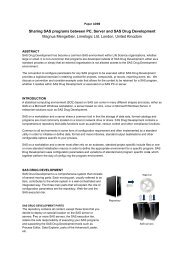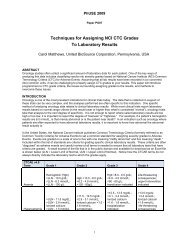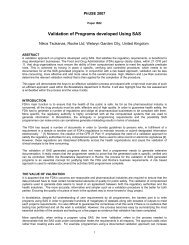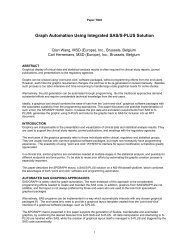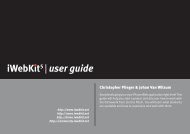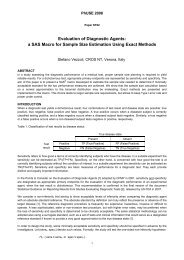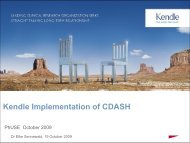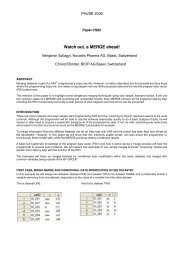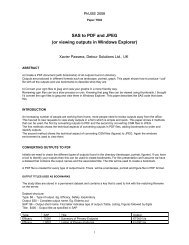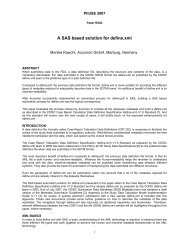Getting your skeletons out of the closet - PhUSE Wiki
Getting your skeletons out of the closet - PhUSE Wiki
Getting your skeletons out of the closet - PhUSE Wiki
You also want an ePaper? Increase the reach of your titles
YUMPU automatically turns print PDFs into web optimized ePapers that Google loves.
<strong>Getting</strong> <strong>your</strong> <strong>skeletons</strong> <strong>out</strong> <strong>of</strong> <strong>the</strong> <strong>closet</strong>Parag NaithaniFerring Pharmaceuticals, CopenhagenPurposeCDISC has laid strict Analysis Data Model Implementation Guideline (ADaMIG), specifying ADaMstandard dataset structures and variables, including naming conventions, labels, types, formats etc. Aprogramming solution is required to effectively adhere to <strong>the</strong> standard with<strong>out</strong> <strong>the</strong> risk <strong>of</strong> making mistakesand duplication <strong>of</strong> work. This paper describes a method which programmatically uses <strong>the</strong> ADaMspecification to shape <strong>the</strong> structure <strong>of</strong> <strong>the</strong> final ADaM datasets.SolutionThis data standardization technique is based on two utilities.This Utility 1 produces empty SAS datasets (ADaM <strong>skeletons</strong>) in a STANDARD library from <strong>the</strong> AnalysisDataset Specification which is stored as a Micros<strong>of</strong>t Word file. This Utility also produces an excel sheetwith <strong>the</strong> metadata information pertaining to <strong>the</strong> individual ADaM domain as well as <strong>the</strong> Mandatory variablesection.The Utility 2 appends last Work.dataset created during <strong>the</strong> development <strong>of</strong> <strong>the</strong> ADaM datasets for eachdomain to <strong>the</strong> respective ADaM skeleton created by Utility 1 to ensure adherence to <strong>the</strong> specificationdocument. It also creates an HTML discrepancy report with clarification on error in structure andclarification on data excisting in <strong>the</strong> skeleton, but not in <strong>the</strong> Work.dataset.PrerequisitesAnalysis dataset specification should exist in a Predefined location and follow a specific ADS templaterequirement. A STANDARD library should be defined for storing <strong>the</strong> <strong>out</strong>puts from <strong>the</strong> Utility. User shouldnot interact with <strong>the</strong> computer while executing <strong>the</strong> macro since it is using <strong>the</strong> user’s computer clipboard.Also <strong>the</strong> Utility macro must be used on a computer having MS Word and Excel installed.
Process Overview Diagram
Subject level ADaM dataset specificationMandatory variables section
Utility 1 (Spec to Skeleton)This utility reads in <strong>the</strong> ADaM specification document and creates 2 types <strong>of</strong> datasets. Firstly it creates <strong>the</strong>Analysis variable metadata for all domains available in <strong>the</strong> specification. Secondly it creates empty SASdatasets(Skeletons) with same structure as Final ADaM dataset for each domain.Analysis variable metadata datasetSkeleton dataset ADSL
Skeleton dataset ADSL properties
Utility 2 (Skeleton to ADaM)Utility 2 is called at <strong>the</strong> end <strong>of</strong> each ADaM dataset creation program. This Utility appends last Work.datasetcreated in <strong>the</strong> program to <strong>the</strong> ADaM skeleton dataset (created by Utility 1) for <strong>the</strong> specific domain. It sorts<strong>the</strong> data according to sorting key available in <strong>the</strong> Analysis variable metadata (created by Utility 1). Also, itcreates an discrepancy reportCalling Utility 2
Last Work.datasetWork.dataset properties
Final ADSL datasetFinal ADSL properties
Discrepancy reportUtility 2 creates a HTML report if <strong>the</strong>re are any structural mismatches in <strong>the</strong> work dataset and <strong>the</strong>corresponding Skeleton dataset. The following errors are handled:• Miss-match in variable type• Length <strong>of</strong> <strong>the</strong> variable in <strong>the</strong> work dataset exceeds that <strong>of</strong> <strong>the</strong> corresponding variable in <strong>the</strong> skeletonThe Final ADaM dataset will NOT be created as <strong>the</strong>se errors are critical in nature.• Variables existing in <strong>the</strong> Skeleton dataset but not in <strong>the</strong> work dataset.This can occur during <strong>the</strong> development phase, but not for <strong>the</strong> final data. In this case, <strong>the</strong> ADaM dataset willbe created.Discrepancy reportUtilities run sequenceUtility 1 is run only when <strong>the</strong>re is a change in <strong>the</strong> ADaM specification document. The change could if a newvariable is added to any domain or a complete new domain is added to <strong>the</strong> specification. Utility 2 is runevery time <strong>the</strong> ADaM dataset creation program is run.
ConclusionProgrammatically using <strong>the</strong> ADaM specification document can improve <strong>the</strong> programming accuracy andefficiency by reducing <strong>the</strong> programming time, maintenance time and validation time. There is no need for<strong>the</strong> programmer to remember which variables to keep or drop. The sequence <strong>of</strong> <strong>the</strong> variables in <strong>the</strong> FinalADaM dataset could be easily governed as <strong>the</strong> Final ADaM dataset will show <strong>the</strong> variables in <strong>the</strong> samesequence as specified in <strong>the</strong> ADaM specification. Using this technique it will be easier to maintain standardswithin and across different trials, thus making <strong>the</strong> data submission ready.Since all <strong>the</strong> variables and <strong>the</strong>ir attributes are listed in a SAS dataset containing <strong>the</strong> Analysis variablemetadata it is easy to check for inconsistencies and make necessary corrections. Also, this utility could beused by <strong>the</strong> sponsor for checking <strong>the</strong> structural inconsistencies in <strong>the</strong> ADaM datasets delivered by <strong>the</strong> CRO.AcknowledgementI would like to thank all my colleagues at Ferring Group who shared <strong>the</strong>ir experiences, patiently answeredall my queries, read through <strong>the</strong> drafts and gave me constructive feedbacks.Contact InformationYour comments and questions are valued and encouraged. Contact <strong>the</strong> author at:Parag Naithaniparag.naithani@ferring.comFerring International PharmaScience Center (IPC)Kay Fiskers Plads 11,DK-2300 Copenhagen



